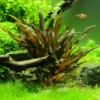Alternanthera reineckii ‘Mini’ [Tc]
₹250.00
| Type: | Stem | |
|---|---|---|
| Origin: | Cultivar | |
| Growth rate: | Medium | |
| Height: | 5 – 10+ | |
| Light demand: | Medium | |
| CO2 : | Medium |
The red Alternanthera reneckii (AR) comes in different varietals, with the AR “mini” gaining popularity these days because it is shorter and redder than the other varietals. In the picture below, we have the shorter “mini” in the foreground and the slightly taller variegated “Rosanervig” behind it. The ‘mini’ varietal is a good foreground/midground plant, while taller varietals such as the ‘rosaefolia’ are suitable for backgrounds in a planted aquarium. They are generally slow growers compared to other stem plants, and can take a certain amount of overcrowding and shading, making them very easy to use in aquascaping.
Alternanthera is slower growing compared to other stem plants and the AR “mini” version can grow very compact. Due to its slower growth nature, it is more forgiving with regards to nutrients or CO2 demand. Using a soil based substrate helps a lot in having stable growth in this particular species.
When trimming, it prefers not to be uprooted & replanted. This means that better results are obtained by cutting off tall shoots and allowing new side shoots to sprout naturally from the remaining base. This technique is scary for newer aquarists as it means you cut off the healthiest looking top portions of the plant, but it gives a denser bush over time and recovery time is actually reduced for this species. You can replant the cut top elsewhere.
Good lighting helps in coloration, as is the case with most colored plants. The ones in the pictures here are grown well in excess of 100umols (PAR) of light. Using higher lighting also allows greater density for leaves. The difficult part is maintaining an algae free tank with more light. Alternanthera reineckii are slow growers and very susceptible to algae. The real test in growing them well is often maintaining an algae free environment long term.
AR “mini” in the foreground and a variegated varietal behind it. The variegated version of Alternanthera reineckii has visible vein patterns and striking foliage.
Key success factors
- Stable tank parameters
- Grows better in soil based substrates
- Vulnerable to algae – so having a clean tank helps
- Dislikes being moved – Do not uproot often, trim away tops and allow rooted base to regrow instead
- Flexible in terms of: temperature, water hardness/alkalinity, CO2 levels
How to get it redder
- Stronger lighting with higher red/blue spectrum
- Good fertilization regime
- Long term consistency
Common problems
Far too often Alternanthera reineckii ends up looking like the sample below with twisted algae covered leaves.
Be the first to review “Alternanthera reineckii ‘Mini’ [Tc]” Cancel reply
You must be logged in to post a review.
Related products
TISSUE CULTURE PLANTS
TISSUE CULTURE PLANTS
TISSUE CULTURE PLANTS
TISSUE CULTURE PLANTS
TISSUE CULTURE PLANTS
TISSUE CULTURE PLANTS
TISSUE CULTURE PLANTS
TISSUE CULTURE PLANTS

![Alternanthera reineckii 'Mini' [Tc]](https://aquasoul.in/wp-content/uploads/2022/06/Alternanthera-Reineckii-Mini.jpg)
![Alternanthera reineckii 'Mini' [Tc] - Image 2](https://aquasoul.in/wp-content/uploads/2022/06/Alternanthera-Reineckii-Mini.webp)




![Limnophila Sp Belem [TC]](https://aquasoul.in/wp-content/uploads/2022/06/LimnophilaBelem-1-300x300.jpg)

![Rotala rotundifolia 'Hi Red' (‘H’ra’) [Tc]](https://aquasoul.in/wp-content/uploads/2022/06/stem-aquarium-32_jpg-300x300.webp)

![Hygrophila corymbosa 'Siamensis' [TC]](https://aquasoul.in/wp-content/uploads/2022/06/hygrophila-corymbosa-300x300.jpg)

![Micranthemum Callitrichoides 'Cuba' [Tc]](https://aquasoul.in/wp-content/uploads/2022/06/hemiantus-callitrichoides-cuba-aquascaping-2-300x300.jpg)

![Proserpinaca Palustris [Tc]](https://aquasoul.in/wp-content/uploads/2022/06/Proserpinaca_palustris_2-min_1800x-300x300.webp)

![Rotala rotundifolia [Tc]](https://aquasoul.in/wp-content/uploads/2022/06/Rotala-rotundifolia-Green-habit-submersed-300x300.jpg)

![Hygrophila pinnatifida [Tc]](https://aquasoul.in/wp-content/uploads/2022/06/Hygrophila-Pinnatifida-1-1024x683-1-300x300.jpeg)

![Ludwigia glandulosa [Tc]](https://aquasoul.in/wp-content/uploads/2022/06/Ludwigiaglandulosa21of1-300x300.jpg)

Reviews
There are no reviews yet.